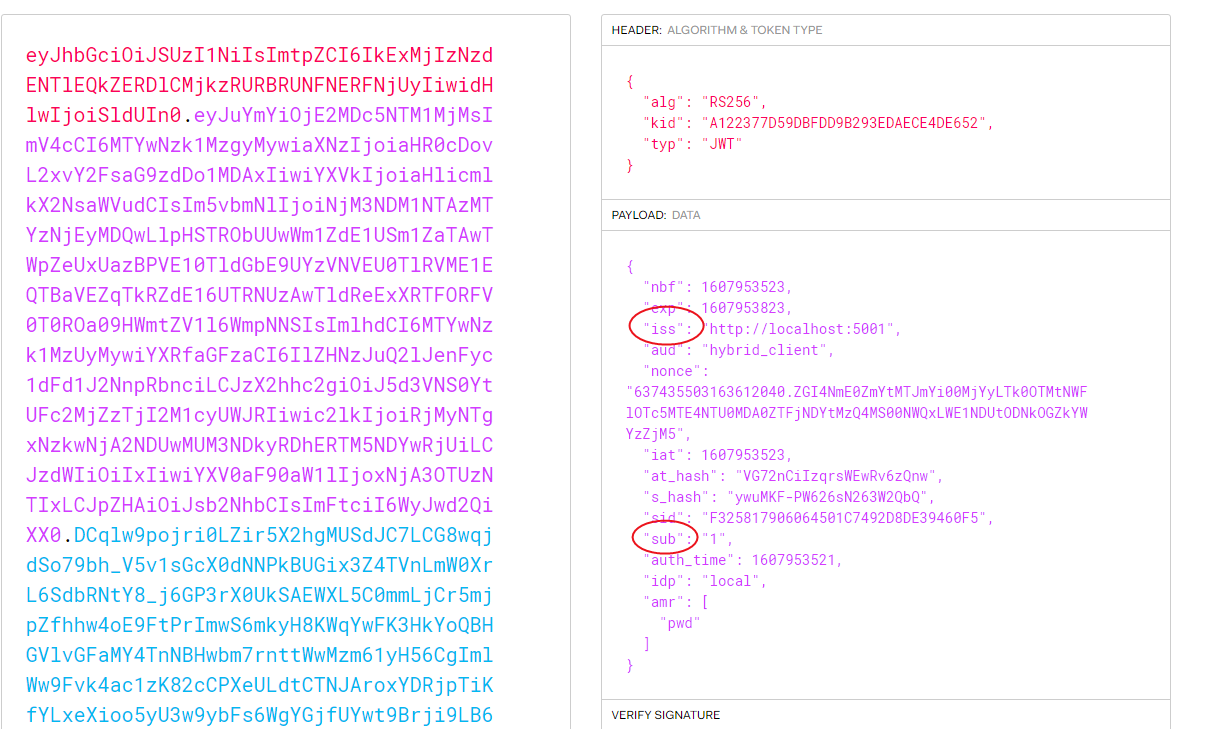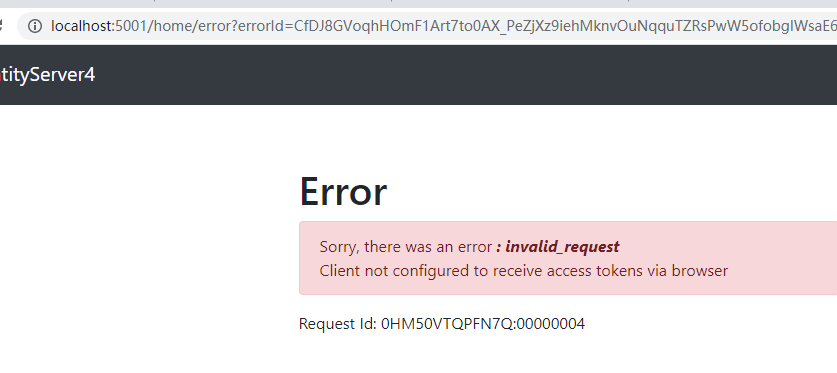IdentityServer4系列 | 混合模式
一、前言
在上一篇关于授权码模式中, 已经介绍了关于授权码的基本内容,认识到这是一个拥有更为安全的机制,但这个仍然存在局限,虽然在文中我们说到通过后端的方式去获取token,这种由web服务器和授权服务器直接通信,不需要经过用户的浏览器或者其他的地方,但是在这种模式中,授权码仍然是通过前端通道进行传递的,而且在访问资源的中,也会将访问令牌暴露给外界,就仍存在安全隐患。
快速回顾一下之前初识基础知识点中提到的,
IdentityServer4是OpenID Connect+OAuth2.0相结合的认证框架,用户身份认证和API的授权访问,两个结合一块,实现了认证和授权的结合。
在几篇关于授权模式篇章中,其中我们也使用了关于OpenID Connect 的简化流程,在简化流程中,所有令牌(身份令牌、访问令牌)都通过浏览器传输,这对于身份令牌(IdentityToken)来说是没有问题的,但是如果是访问令牌(AccessToken)直接通过浏览器传输,就增加了一定的安全问题。因为访问令牌比身份令牌更敏感,在非必须的情况下,我们不希望将它们暴露给外界。
所以我们就会考虑增加安全性,在OpenID Connect 包含一个名为“Hybrid(混合)”的流程,它为我们提供了两全其美的优势,身份令牌通过浏览器传输,因此客户端可以在进行任何更多工作之前对其进行验证。如果验证成功,客户端会通过令牌服务的以获取访问令牌。
二、初识
在认识混合模式(Hybrid Flow)时候,可以发现这里跟上一篇的授权码模式有很多相似的地方,具体可以查看授权码模式
查看使用OpenIDConnect时的安全性和隐私注意事项相关资料可以发现,
授权码模式和混合模式的流程步骤分别如下:
Authorization Code Flow Steps
The Authorization Code Flow goes through the following steps.
- Client prepares an Authentication Request containing the desired request parameters.
- Client sends the request to the Authorization Server.
- Authorization Server Authenticates the End-User.
- Authorization Server obtains End-User Consent/Authorization.
- Authorization Server sends the End-User back to the Client with an Authorization Code.
- Client requests a response using the Authorization Code at the Token Endpoint.
- Client receives a response that contains an ID Token and Access Token in the response body.
- Client validates the ID token and retrieves the End-User's Subject Identifier.
Hybrid Flow Steps
The Hybrid Flow follows the following steps:
- Client prepares an Authentication Request containing the desired request parameters.
- Client sends the request to the Authorization Server.
- Authorization Server Authenticates the End-User.
- Authorization Server obtains End-User Consent/Authorization.
- Authorization Server sends the End-User back to the Client with an Authorization Code and, depending on the Response Type, one or more additional parameters.
- Client requests a response using the Authorization Code at the Token Endpoint.
- Client receives a response that contains an ID Token and Access Token in the response body.
- Client validates the ID Token and retrieves the End-User's Subject Identifier.
由以上对比发现,code和hybrid一样都有8个步骤,大部分步骤也是相同的。最主要的区别在于第5步。
在授权码模式中,成功响应身份验证:
HTTP/1.1 302 Found
Location: https://client.example.org/cb?
code=SplxlOBeZQQYbYS6WxSbIA
&state=af0ifjsldkj
在混合模式中,成功响应身份验证:
HTTP/1.1 302 Found
Location: https://client.example.org/cb#
code=SplxlOBeZQQYbYS6WxSbIA
&id_token=eyJ0 ... NiJ9.eyJ1c ... I6IjIifX0.DeWt4Qu ... ZXso
&state=af0ifjsldkj
其中多了一个id_token
在使用这些模式的时候,成功的身份验证响应,存在指定的差异。这些授权端点的结果以不同的的依据返回。其中code是一定会返回的,access_token和id_token的返回依据 response_type 参数决定。
混合模式根据response_type的不同,authorization endpoint返回可以分为三种情况。
- response_type = code + id_token ,即包含Access Token和ID Token
- response_type = code + token ,即包含Authorization Code和Access Token
- response_type = code + id_token + token,即包含Authorization Code、identity Token和Access Token
三、实践
接着我们进行一些简单的实践,因为有了前面授权码模式代码的经验,编写混合模式也是很简单的。
(这里重复之前的代码,防止被爬抓后内容的缺失不完整)
在示例实践中,我们将创建一个授权访问服务,定义一个MVC客户端,MVC客户端通过IdentityServer上请求访问令牌,并使用它来访问API。
3.1 搭建 Authorization Server 服务
搭建认证授权服务
3.1.1 安装Nuget包
IdentityServer4程序包
3.1.2 配置内容
建立配置内容文件Config.cs
public static class Config
{
public static IEnumerable<IdentityResource> IdentityResources =>
new IdentityResource[]
{
new IdentityResources.OpenId(),
new IdentityResources.Profile(),
};
public static IEnumerable<ApiScope> ApiScopes =>
new ApiScope[]
{
new ApiScope("hybrid_scope1")
};
public static IEnumerable<ApiResource> ApiResources =>
new ApiResource[]
{
new ApiResource("api1","api1")
{
Scopes={ "hybrid_scope1" },
UserClaims={JwtClaimTypes.Role}, //添加Cliam 角色类型
ApiSecrets={new Secret("apipwd".Sha256())}
}
};
public static IEnumerable<Client> Clients =>
new Client[]
{
new Client
{
ClientId = "hybrid_client",
ClientName = "hybrid Auth",
ClientSecrets = { new Secret("511536EF-F270-4058-80CA-1C89C192F69A".Sha256()) },
AllowedGrantTypes = GrantTypes.Hybrid,
RedirectUris ={
"http://localhost:5002/signin-oidc", //跳转登录到的客户端的地址
},
// RedirectUris = {"http://localhost:5002/auth.html" }, //跳转登出到的客户端的地址
PostLogoutRedirectUris ={
"http://localhost:5002/signout-callback-oidc",
},
ClientSecrets = { new Secret("511536EF-F270-4058-80CA-1C89C192F69A".Sha256()) },
AllowedScopes = {
IdentityServerConstants.StandardScopes.OpenId,
IdentityServerConstants.StandardScopes.Profile,
"hybrid_scope1"
},
//允许将token通过浏览器传递
AllowAccessTokensViaBrowser=true,
// 是否需要同意授权 (默认是false)
RequireConsent=true
}
};
}
RedirectUris: 登录成功回调处理的客户端地址,处理回调返回的数据,可以有多个。
PostLogoutRedirectUris:跳转登出到的客户端的地址。这两个都是配置的客户端的地址,且是identityserver4组件里面封装好的地址,作用分别是登录,注销的回调
因为是混合授权的方式,所以我们通过代码的方式来创建几个测试用户。
新建测试用户文件TestUsers.cs
public class TestUsers
{
public static List<TestUser> Users
{
get
{
var address = new
{
street_address = "One Hacker Way",
locality = "Heidelberg",
postal_code = 69118,
country = "Germany"
};
return new List<TestUser>
{
new TestUser
{
SubjectId = "1",
Username = "i3yuan",
Password = "123456",
Claims =
{
new Claim(JwtClaimTypes.Name, "i3yuan Smith"),
new Claim(JwtClaimTypes.GivenName, "i3yuan"),
new Claim(JwtClaimTypes.FamilyName, "Smith"),
new Claim(JwtClaimTypes.Email, "i3yuan@email.com"),
new Claim(JwtClaimTypes.EmailVerified, "true", ClaimValueTypes.Boolean),
new Claim(JwtClaimTypes.WebSite, "http://i3yuan.top"),
new Claim(JwtClaimTypes.Address, JsonSerializer.Serialize(address), IdentityServerConstants.ClaimValueTypes.Json)
}
}
};
}
}
}
返回一个TestUser的集合。
通过以上添加好配置和测试用户后,我们需要将用户注册到IdentityServer4服务中,接下来继续介绍。
3.1.3 注册服务
在startup.cs中ConfigureServices方法添加如下代码:
public void ConfigureServices(IServiceCollection services)
{
var builder = services.AddIdentityServer()
.AddTestUsers(TestUsers.Users); //添加测试用户
// in-memory, code config
builder.AddInMemoryIdentityResources(Config.IdentityResources);
builder.AddInMemoryApiScopes(Config.ApiScopes);
builder.AddInMemoryApiResources(Config.ApiResources);
builder.AddInMemoryClients(Config.Clients);
// not recommended for production - you need to store your key material somewhere secure
builder.AddDeveloperSigningCredential();
services.ConfigureNonBreakingSameSiteCookies();
}
3.1.4 配置管道
在startup.cs中Configure方法添加如下代码:
public void Configure(IApplicationBuilder app, IWebHostEnvironment env)
{
if (env.IsDevelopment())
{
app.UseDeveloperExceptionPage();
}
app.UseStaticFiles();
app.UseRouting();
app.UseCookiePolicy();
app.UseAuthentication();
app.UseAuthorization();
app.UseIdentityServer();
app.UseEndpoints(endpoints =>
{
endpoints.MapDefaultControllerRoute();
});
}
以上内容是快速搭建简易IdentityServer项目服务的方式。
这搭建 Authorization Server 服务跟上一篇授权码模式有何不同之处呢?
- 在Config中配置客户端(client)中定义了一个
AllowedGrantTypes的属性,这个属性决定了Client可以被哪种模式被访问,GrantTypes.Hybrid为混合模式。所以在本文中我们需要添加一个Client用于支持授权码模式(Hybrid)。
3.2 搭建API资源
实现对API资源进行保护
3.2.1 快速搭建一个API项目
3.2.2 安装Nuget包
IdentityServer4.AccessTokenValidation 包
3.2.3 注册服务
在startup.cs中ConfigureServices方法添加如下代码:
public void ConfigureServices(IServiceCollection services)
{
services.AddControllersWithViews();
services.AddAuthentication(JwtBearerDefaults.AuthenticationScheme)
services.AddAuthentication("Bearer")
.AddIdentityServerAuthentication(options =>
{
options.Authority = "http://localhost:5001";
options.RequireHttpsMetadata = false;
options.ApiName = "api1";
options.ApiSecret = "apipwd"; //对应ApiResources中的密钥
});
}
AddAuthentication把Bearer配置成默认模式,将身份认证服务添加到DI中。
AddIdentityServerAuthentication把IdentityServer的access token添加到DI中,供身份认证服务使用。
3.2.4 配置管道
在startup.cs中Configure方法添加如下代码:
public void Configure(IApplicationBuilder app, IWebHostEnvironment env)
{
if (env.IsDevelopment())
{
app.UseDeveloperExceptionPage();
}
app.UseRouting();
app.UseAuthentication();
app.UseAuthorization();
app.UseEndpoints(endpoints =>
{
endpoints.MapDefaultControllerRoute();
});
}
UseAuthentication将身份验证中间件添加到管道中;
UseAuthorization 将启动授权中间件添加到管道中,以便在每次调用主机时执行身份验证授权功能。
3.2.5 添加API资源接口
[Route("api/[Controller]")]
[ApiController]
public class IdentityController:ControllerBase
{
[HttpGet("getUserClaims")]
[Authorize]
public IActionResult GetUserClaims()
{
return new JsonResult(from c in User.Claims select new { c.Type, c.Value });
}
}
在IdentityController 控制器中添加 [Authorize] , 在进行请求资源的时候,需进行认证授权通过后,才能进行访问。
3.3 搭建MVC 客户端
实现对客户端认证授权访问资源
3.3.1 快速搭建一个MVC项目
3.3.2 安装Nuget包
IdentityServer4.AccessTokenValidation 包
3.3.3 注册服务
要将对 OpenID Connect 身份认证的支持添加到MVC应用程序中。
在startup.cs中ConfigureServices方法添加如下代码:
public void ConfigureServices(IServiceCollection services)
{
services.AddControllersWithViews();
services.AddAuthorization();
services.AddAuthentication(options =>
{
options.DefaultScheme = "Cookies";
options.DefaultChallengeScheme = "oidc";
})
.AddCookie("Cookies") //使用Cookie作为验证用户的首选方式
.AddOpenIdConnect("oidc", options =>
{
options.Authority = "http://localhost:5001"; //授权服务器地址
options.RequireHttpsMetadata = false; //暂时不用https
options.ClientId = "hybrid_client";
options.ClientSecret = "511536EF-F270-4058-80CA-1C89C192F69A";
options.ResponseType = "code id_token"; //代表
options.Scope.Add("hybrid_scope1"); //添加授权资源
options.SaveTokens = true; //表示把获取的Token存到Cookie中
options.GetClaimsFromUserInfoEndpoint = true;
});
services.ConfigureNonBreakingSameSiteCookies();
}
AddAuthentication注入添加认证授权,当需要用户登录时,使用cookie来本地登录用户(通过“Cookies”作为DefaultScheme),并将DefaultChallengeScheme设置为“oidc”,- 使用
AddCookie添加可以处理 cookie 的处理程序。- 在
AddOpenIdConnect用于配置执行OpenID Connect协议的处理程序和相关参数。Authority表明之前搭建的 IdentityServer 授权服务地址。然后我们通过ClientId、ClientSecret,识别这个客户端。SaveTokens用于保存从IdentityServer获取的token至cookie,ture标识ASP.NETCore将会自动存储身份认证session的access和refresh token。- 我们在配置
ResponseType时需要使用Hybrid定义的三种情况之一,具体代码如上所述。
3.3.4 配置管道
然后要确保认证服务执行对每个请求的验证,加入UseAuthentication和UseAuthorization到Configure中,在startup.cs中Configure方法添加如下代码:
public void Configure(IApplicationBuilder app, IWebHostEnvironment env)
{
if (env.IsDevelopment())
{
app.UseDeveloperExceptionPage();
}
else
{
app.UseExceptionHandler("/Home/Error");
}
app.UseStaticFiles();
app.UseRouting();
app.UseCookiePolicy();
app.UseAuthentication();
app.UseAuthorization();
app.UseEndpoints(endpoints =>
{
endpoints.MapControllerRoute(
name: "default",
pattern: "{controller=Home}/{action=Index}/{id?}");
});
}
UseAuthentication将身份验证中间件添加到管道中;
UseAuthorization 将启动授权中间件添加到管道中,以便在每次调用主机时执行身份验证授权功能。
3.3.5 添加授权
在HomeController控制器并添加[Authorize]特性到其中一个方法。在进行请求的时候,需进行认证授权通过后,才能进行访问。
[Authorize]
public IActionResult Privacy()
{
ViewData["Message"] = "Secure page.";
return View();
}
还要修改主视图以显示用户的Claim以及cookie属性。
@using Microsoft.AspNetCore.Authentication
<h2>Claims</h2>
<dl>
@foreach (var claim in User.Claims)
{
<dt>@claim.Type</dt>
<dd>@claim.Value</dd>
}
</dl>
<h2>Properties</h2>
<dl>
@foreach (var prop in (await Context.AuthenticateAsync()).Properties.Items)
{
<dt>@prop.Key</dt>
<dd>@prop.Value</dd>
}
</dl>
访问 Privacy 页面,跳转到认证服务地址,进行账号密码登录,Logout 用于用户的注销操作。
3.3.6 添加资源访问
在HomeController控制器添加对API资源访问的接口方法。在进行请求的时候,访问API受保护资源。
/// <summary>
/// 测试请求API资源(api1)
/// </summary>
/// <returns></returns>
public async Task<IActionResult> getApi()
{
var client = new HttpClient();
var accessToken = await HttpContext.GetTokenAsync(OpenIdConnectParameterNames.AccessToken);
if (string.IsNullOrEmpty(accessToken))
{
return Json(new { msg = "accesstoken 获取失败" });
}
client.DefaultRequestHeaders.Authorization = new AuthenticationHeaderValue("Bearer", accessToken);
var httpResponse = await client.GetAsync("http://localhost:5003/api/identity/GetUserClaims");
var result = await httpResponse.Content.ReadAsStringAsync();
if (!httpResponse.IsSuccessStatusCode)
{
return Json(new { msg = "请求 api1 失败。", error = result });
}
return Json(new
{
msg = "成功",
data = JsonConvert.DeserializeObject(result)
});
}
测试这里通过获取accessToken之后,设置client请求头的认证,访问API资源受保护的地址,获取资源。
3.4 效果
我们通过对比授权码模式与混合模式 可以发现,在大部分步骤是相同的,但也存在一些差异。
在整个过程中,我们使用抓取请求,可以看到在Authorization Endpoint中两者的区别如下:
授权码模式:

混合模式:

在Authorization EndPoint返回的Id_Token和Token EndPoint返回的id_Token中,可以看到两次值是可能不相同的,但是其中包含的用户信息都是一样的。

在使用Hybrid时我们看到授权终结点返回的Id Token中包含at_hash(Access Token的哈希值)和s_hash(State的哈希值),规范中定义了以下的一些检验规则。
- 两个id_token中的 iss 和 sub 必须相同。
- 如果任何一个 id token 中包含关于终端用户的声明,两个令牌中提供的值必须相同。
- 关于验证事件的声明必须都提供。
- at_hash 和 s_hash 声明可能会从 token 端点返回的令牌中忽略,即使从 authorize 端点返回的令牌中已经声明。
四、问题
4.1 设置RequirePkce
在指定基于授权码的令牌是否需要验证密钥,默认为true。

解决方法:
修改Config中的RequirePkce为false即可。这样服务端便不在需要客户端提供code challeng。
RequirePkce = false,//v4.x需要配置这个
4.2 设置ResponseType
在上文中提到的MVC客户端中配置ResponseType时可以使用Hybrid定义的三种情况。
而当设置为"code token", "code id_token token"中的一种,即只要包含token,都会报如下错误:

解决方法:
授权服务端中的Config中增加允许将token通过浏览器传递
AllowAccessTokensViaBrowser = true,
五、总结
-
由于令牌都通过浏览器传输,为了提高更好的安全性,我们不想暴露访问令牌,
OpenID Connect包含一个名为“Hybrid(混合)”的流程,它可以让身份令牌(id_token)通过前端浏览器通道传输,因此客户端可以在做更多的工作之前验证它。 如果验证成功,客户端会打开令牌服务的后端服务器通道来检索访问令牌(access_token)。 -
在后续会对这方面进行介绍继续说明,数据库持久化问题,以及如何应用在API资源服务器中和配置在客户端中,会进一步说明。
-
如果有不对的或不理解的地方,希望大家可以多多指正,提出问题,一起讨论,不断学习,共同进步。



 浙公网安备 33010602011771号
浙公网安备 33010602011771号